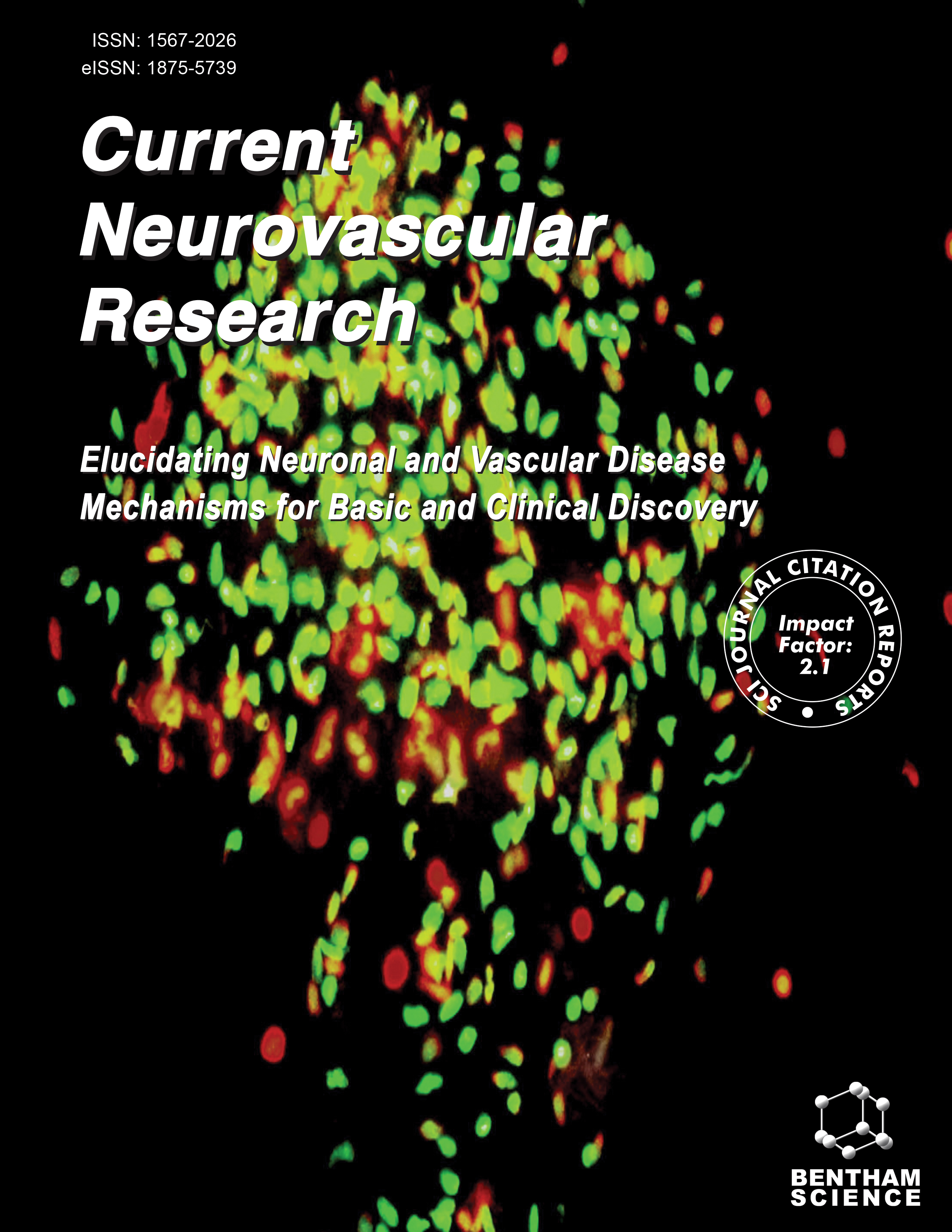- Home
- A-Z Publications
- Current Neurovascular Research
- Previous Issues
- Volume 12, Issue 2, 2015
Current Neurovascular Research - Volume 12, Issue 2, 2015
Volume 12, Issue 2, 2015
-
-
Low Estimated Glomerular Filtration Rate is Associated with High Recurrence Rate and Poor Prognosis of Hemorrhage Stroke
More LessAuthors: Sun Kai, Qu Jiaoyan, Song Weihua, Zhang Yinhui, Zhang Channa, Song Li, Song Yan, Hui Rutai and Chen JingzhouThis study investigated whether a low estimated glomerular filtration rate (eGFR) leads to a higher risk of stroke recurrence and a poor prognosis in hemorrhagic stroke patients. A total of 2000 stroke patients were recruited during 2000-2001 and prospectively followed up for a median of 4.5 years. The independent association of a low eGFR with stroke recurrence and poor prognosis was evaluated using Kaplan–Meier analysis Read More
-
-
-
Uric Acid and Cu/Zn Superoxide Dismutase: Potential Strategies and Biomarkers in Functional Recovery of Post-Acute Ischemic Stroke Patients after Intensive Neurorehabilitation
More LessNo evidence is currently provided on the involvement of uric acid (UA) and Cu/Zn Superoxide Dismutase (Cu/Zn SOD) in functional recovery of stroke patients after neurorehabilitation. For this purpose, the relationship between UA and Cu/Zn SOD plasma levels and clinical and functional outcome measures were analysed in twenty-five post-acute stroke patients undergoing intensive neurorehabilitation. UA and Cu/Zn SOD Read More
-
-
-
An Experimental Model for Exudative Age-related Macular Degeneration with Choroidal Neovascularization Using the Common Marmoset
More LessAuthors: Masamitsu Shimazawa, Tomomi Masuda, Shinsuke Nakamura, Miki Miwa, Katsuki Nakamura and Hideaki HaraThis study aimed to establish an experimental exudative age-related macular degeneration (AMD) model in the common marmoset (Callithrix jacchus), which is a small New World monkey. Choroidal neovascularization (CNV) was induced by laser irradiation on the left eye of each animal under anesthesia. Eight laser spots were applied around the macular area using the image-guided laser system (532 nm) attached with Read More
-
-
-
Etanercept Improves Cognitive Performance and Increases eNOS and BDNF Expression During Experimental Vascular Dementia in Streptozotocin- induced Diabetes
More LessAuthors: Tijen Utkan, Yusufhan Yazir, Ayse Karson and Dilek BayramgurlerDiabetes mellitus (DM) is related to an increase in the incidence of vascular dementia. Inflammation is an important cause of endothelial dysfunction and cognitive deficits. The anti -tumor necrosis factor (TNF)-α fusion protein etanercept has been reported to exhibit memory-enhancing effects and endothelial protection. We tested the effect of etanercept on the cognitive endpoints and compared it with the co Read More
-
-
-
Obesity Promotes Oxidative Stress and Exacerbates Sepsis-induced Brain Damage
More LessSepsis is a severe clinical syndrome in which a system-wide inflammatory response follows initial attempts to eliminate pathogens. It is not novel that in sepsis the brain is one of the first organs affected which causes an increase in morbidity and mortality and its consequences may be exacerbated when associated with a diagnosis of chronic inflammation, such as in obesity. Thus, the aim of the present study is to evalu Read More
-
-
-
Granulocyte Colony-stimulating Factor and Bone Marrow Mononuclear Cells for Stroke Treatment in the Aged Brain
More LessIschemic stroke swiftly induces a wide spectrum of pathophysiological sequelae, particularly in the aged brain. The translational failure of experimental therapies, might partially be related to monotherapeutic approaches, not address potential counter-mechanisms sufficiently or within the best time window. For example, therapeutic effects relying on stem/progenitor cell mobilization by granulocyte-colony stimulating fa Read More
-
-
-
Cocaine Dependence and Stroke: Pathogenesis and Management
More LessCocaine abuse remains a devastating medical problem for our society. Current concepts suggest that both hemorrhagic and ischemic stroke, particularly in young people, can result as a consequence of cocaine exposure. We provide an analysis of mechanisms of injury and a discussion of the pharmacological management of stroke following cocaine use. Preclinical research suggests that the cause of cocaine-mediated str Read More
-
-
-
Programming Apoptosis and Autophagy with Novel Approaches for Diabetes Mellitus
More LessAccording to the World Health Organization, diabetes mellitus (DM) in the year 2030 will be ranked the seventh leading cause of death in the world. DM impacts all systems of the body with oxidant stress controlling cell fate through endoplasmic reticulum stress, mitochondrial dysfunction, alterations in uncoupling proteins, and the induction of apoptosis and autophagy. Multiple treatment approaches are being entertained f Read More
-
-
-
Proliferative Retinopathies: Animal Models and Therapeutic Opportunities
More LessAuthors: Pilar Villacampa, Virginia Haurigot and Fatima BoschProliferative retinopathies are the leading causes of blindness in Western societies. The development of new, more efficacious treatments that take advantage of recent advances in the fields of gene and cell therapy requires further investigations on the mechanisms underlying disease onset and progression, and adequate animal models that recapitulate the pathogenesis of human proliferative retinopathy and allow evaluatio Read More
-
-
-
Is There A Pulse Wave Encephalopathy Component To Multiple Sclerosis?
More LessThe dominant hypothesis in multiple sclerosis is that it is an autoimmune disease; however, there is considerable evidence that the immune attack on myelin may be secondary to a cytodegenerative event. Furthermore, the immune modulating therapies longest in clinical use, although modulating the frequency and severity of exacerbation, do not affect long-term progression towards disability. Clearly alternative perspe Read More
-
Volumes & issues
-
Volume 21 (2024)
-
Volume 20 (2023)
-
Volume 19 (2022)
-
Volume 18 (2021)
-
Volume 17 (2020)
-
Volume 16 (2019)
-
Volume 15 (2018)
-
Volume 14 (2017)
-
Volume 13 (2016)
-
Volume 12 (2015)
-
Volume 11 (2014)
-
Volume 10 (2013)
-
Volume 9 (2012)
-
Volume 8 (2011)
-
Volume 7 (2010)
-
Volume 6 (2009)
-
Volume 5 (2008)
-
Volume 4 (2007)
-
Volume 3 (2006)
-
Volume 2 (2005)
-
Volume 1 (2004)
Most Read This Month
Article
content/journals/cnr
Journal
10
5
false
en


